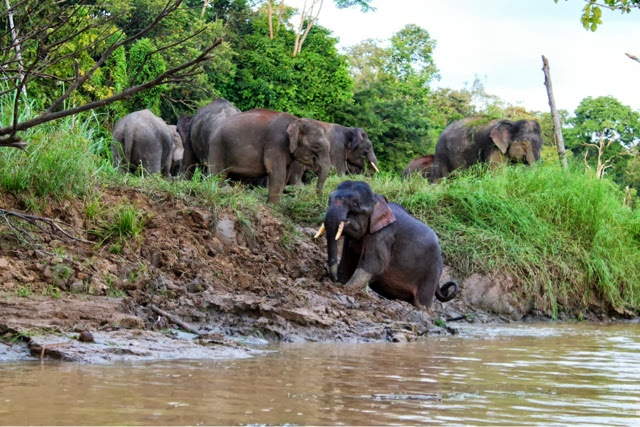Upon arrival, we were fitted with flattering hard hats and equipped with a torch to take into the gloomy caves. Walking from the entrance of the attraction to the mouth of the cave along a boardwalk, we passed under the forest canopy, keenly watching for any more wildlife along the way. On the way we were also shown one of the birds nests which can sell for anywhere up to $50- not bad for something made out of saliva. We reached the huge mouth of the cave and were greeted by one of the vilest smells either of us have ever encountered. A combination of bird poo, bat poo, cockroaches and ammonia made it decidedly unpleasant.
Walking into the cave we saw a whole host of creepy crawlies- long-legged centipedes, cockroaches and spiders. One of my pet hates is cockroaches and having millions of them scuttling around my feet in a smelly cave did not equate to a happy experience for me, so I decided to go and sit outside after a few minutes inside. Rob continued the tour and saw rats (even more of a reason for me to leave), birds droppings, bats (including dead bats being eaten by cockroaches) and swiftlets who are the producers of the birds nests. Here are a few photos he took of these lovely things....
When he emerged from the cave, we waited a little while in case we could spot one of the orangutans who reside in the area. We couldn't see one so we made our way back to the van thinking there was nothing else to see. However, on the way we saw a flash of orange and thought our luck had changed! We went to further investigate, but discovered instead of an orangutan a red-leaf monkey (another primate indigenous to the region) perched on one of the trees. Their fur is very similar to orangutans although they are much smaller and have very long tails. Taking a closer look, we could see that their faces were far different to other monkeys, almost resembling that of a little old man.
We got back to the coach and made the two-hour drive back to Sandakan which turned into a bit of a road trip with the driver cracking out the Bon Jovi and various car snacks which him and Wassil seemed way too excited about. We stopped for another buffet lunch on the way, then went on to our first stop- the War Memorial Park. Another aspect of history which Rob and I were previously unaware of is the Japanese Occupation of Sabah during the latter half of World War II. The memorial park is dedicated to the thousands of Australian and British POWs who perished during the death marches of the time, along with the thousands of Sabah people who died as a result of the poor conditions in Borneo at the time of the occupation.
The museum explained the history of the Japanese Occupation. When the Japanese occupied the area, they planned to use the land to build an airstrip. Contrary to the Geneva Convention, they shipped thousands of Australian and British POWs from Singapore to build it. The conditions that these soldiers were kept in were atrocious and it is hard to believe that this was the case in such recent years. Many died from tropical illnesses including malaria, and those that survived their years in the camp were forced in 1944 to march with supplies to Randau or be killed. The walk was nearly 300km and most were equipped only with loin clothes, already severely weakened by their time in the camps. Most died on the way and those that didn't were then forced to march back. Only 6 survived- all Australian- and they were all escapees.
Sabah is now an independently governed state, although it is owned by Malaysia. Wassil provided us with some more information about the history of the region as a colony for various countries across the years. The other state which forms Malaysian Borneo is Sarawak and this has had an equally tumultuous history on its road to independence.
After a thought-provoking visit, we made our way to the next stop on our tour- the Puu Jih Shih Temple. A modern Chinese Buddhist temple on the top of a hill this affords a gorgeous view over the harbour. Swastikas were seen all over the temple, the symbol of peace in Buddhism, pointing in the opposite direction to the Nazi symbol. One was even planted in flowers in the gardens. The temple had cost $5 million to build and is one of the most notable temples of the region.
After the temple we headed to our final destination, the local water village- Buli Sim Sim. The village is made up of houses and shops which are on stilts above the shallow sea water below, and which are all painted in bright colours. It seems to be something of a status symbol to live in the region and it apparently has some of the highest property prices in Sandakan. The locals obviously take pride in their houses and the fronts of the houses are very well maintained.
Walking to the end of the jetty granted us an excellent view of some of the smaller islands off the Bornean Coast. One of the islands was where some of the 6 survivors of the death marches escaped to, and this tied the history of the region together in our minds.
Reaching the end of our tour, we were ready for some time to relax during our remaining few days in Sandakan. Recovering from a virus (which I think I accidentally transmitted to Wassil and Rob, oops) we did very little except have a few lie ins, watch too many DVDs, cook some food, indulge in some junk food and do a little bit of shopping. This all prepared us for our week in Peninsular Malaysia which we are currently enjoying...












































